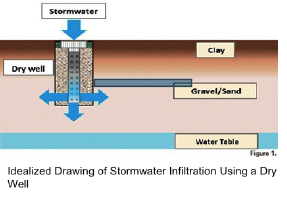Elk Grove Dry Wells as Low Impact Development Tool
The City of Elk Grove, Cal/EPA's Office of Environmental Health Hazard Assessment (OEHHA), Willdan Engineering, and consulting hydrologists have teamed together to study the potential environmental benefits and/or risks associated with the use of dry wells as a Low Impact Development (LID) tool. The purpose of the project was to determine whether dry wells, in concert with other LID practices, are a cost-effective way to infiltrate stormwater, alleviate localized flooding, and recharge the aquifer without adversely affecting groundwater quality. The project is located 15 miles south of the State's capital, in Elk Grove, California, and was funded by the California State Water Resources Control Board's Proposition 84 (Prop 84) Storm Water Grant Program (SWGP) Planning Grant.
What is a Dry Well?
Dry wells, also known as underground injection control (UIC) systems, are stormwater infiltration devices typically constructed of a pipe approximately 3 feet wide and 20 to 50 feet deep, containing perforation at various locations along the pipe and/or at the bottom. Dry wells can be used in a variety of situations, but are especially useful in areas with clay soils to help facilitate the movement of stormwater runoff below the constricting clay layers. They are a stormwater best management practices (BMPs) to infiltrate water into the ground to reduce runoff; are relatively easy to construct; and require little land area. Dry wells can be used in conjunction with low impact development (LID) practices to help infiltrate and retain, filter, or slowly release stormwater at a given site(s). Numerous designs have been used; some includes pretreatment features such as vegetated swales and sedimentation basins that help trap sediment and other pollutants. These features will help to minimize clogging in the dry well as well as reducing contaminates released into the subsurface.
Dry wells can also provide additional benefits such as reducing the adverse effects of hydromodification on surface water quality and aquatic habitat, localized flood reduction and groundwater recharge; and can also help to adapt to the effects of drought and climate change.
Why Use a Dry Well?
A dry well is a stormwater runoff reduction tools that can be used to achieve the goals of minimizing hydrologic changes associated with urbanization. As impervious surfaces expand with urbanization, rain is unable to penetrate the soil. This creates large volumes of runoff that are typically directed into piped stormwater conveyance system which increases the volume of runoff and the speed in which it reaches local waterways. This change in the urban hydrograph reduces the potential for groundwater recharge and damages aquatic habitat in creeks and rivers. Dry wells can help minimize these effects by allowing stormwater to bypass soils with poor infiltration rates (Class C and D soils) to reach more permeable layers.
These qualities of dry wells make them a useful tool to help meet stormwater management requirements issued by the State and Regional Water Boards throughout California. Dry wells also provide a sustainable and environmentally friendly drainage solution that avoids costly, underground mechanical devices and can serve as a Low Impact Development (LID) tool. They can incorporate pretreatment features such as grassy swales and sedimentation basins for additional stormwater treatment. Dry wells can protect waterways from erosion caused by direct stormwater discharge and reduce the harmful effects that traditional stormwater management practices have had on the aquatic ecosystem. Dry wells not only aid in stormwater runoff reduction and increase groundwater recharge, but they can also minimize the risk of flooding, are economical and have minimal space requirements.
Dry Well Use for Local, Regional and State Stormwater and Flood Control Managers
Dry wells can help meet important regulatory guidelines for local, regional and State stormwater and flood control managers in California as follows:
- Regulations of the National Pollutant Discharge Elimination System (NPDES) permit require municipalities, the construction industry, and others to retain a high percentage of stormwater runoff volume for smaller storms (10-year events and less) on-site in order to avoid degradation of aquatic habitat in creeks and rivers. Using Low Impact Development (LID) practices to achieve these goals can be challenging if the soils have a high clay composition (Class C and D). By breaking through the clay layers, a dry well allows stormwater runoff to reach more pervious layers beneath the ground.
- Many California cities, small and large, are struggling to meet the water needs of their communities. The groundwater table is dropping in many regions of the State due to over drought. As a consequence, many communities are looking at stormwater as a potential resource for groundwater augmentation. These cities are investigating ways to incorporate dry wells into their stormwater management systems primarily to address the issue of water shortage.
- Dry wells keep stormwater out of sewers, eliminate the need for curb drains and piping. They can be cost-effective and can be particularly useful in urban areas where space is limited.
- Dry wells can be viewed as a climate change adaptation. Climate change models suggest that the form and amount of precipitation in the Sierras is likely to change from one which is characterized by a high volume of water stored as snow to rain. The dams in California were not constructed to manage this pattern of precipitation. Dry wells might provide an option for capturing rain and runoff to recharge the aquifer.
- Where space is limited and traditional conveyance systems are too expensive to construct, dry wells can help to minimize the risk of localized flooding. A dry well is a simple way to manage stormwater runoff and to reduce localized flooding. For example, dry wells can be installed in a roadside ditch or streetscape.
California does not currently have a statewide set of standards or regulations governing the use of dry wells. The oversight of dry well use generally falls upon local jurisdictions and/or the Regional Water Boards. However, there are approximately 15 states around the country which possess guidelines for siting and construction of dry wells, a registration process, which usually includes payment of a fee, and requirements for maintenance and/or monitoring.
Arizona and Oregon (where dry wells are called Underground Injection Control Systems) (UICS), for example, use dry wells extensively as stormwater and flood control management tools. However, in California, they are used infrequently and with caution due to the concern that they provide a conduit for contaminants to enter the groundwater.
As part of the City of Elk Grove's study, a series of fact sheets and a literature review were developed to provide scientific information on the risks associated with dry well use as well as practices used around the U.S.
Contact
| Dry Well Project | |
|---|---|
Engineering Services Support ManagerShoaib Ahrary, PE |
|


